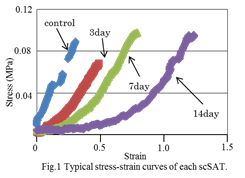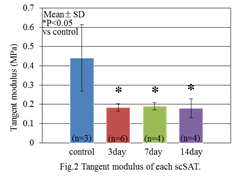Introduction: A stem cell-based self-assemble tissue (scSAT) biosynthesized using synovium-derived mesenchymal stem cells (MSCs) has a great potential for cartilage repair [1]. However, the mechanical properties of cartilage-like tissues repaired using the scSAT were still low even though it was implanted into a partial defect [2]. We have two remedial measures to the problem. First, the scSAT is cultured on a collagen sheet (CS) to produce a scSAT/CS composite [3]. Second, both the scsAT and scSAT/CS composite are produced though a cell culture under the application of compressive loading. As regard with the second measure, it has been already reported that static compressive loading promoted the generation of extracellular matrix (ECM) [4]. In the present study, scSATs were cultured under static compressive loading and the tensile and morphological properties were determined.
Methods: MSCs were obtained from the synovial membranes of rabbit knee joints. After 4-time passage, MSCs were cultured on a 6-well culture dish at a cell density of 4×105 cells/cm2 in culture medium (DMEM + 10%FBS) supplemented with 0.2 mM ascorbic acid-2 phosphate. Static compressive load of 72 Pa was applied to the composite for either the last 3 days, 7 days, or 14 days within the total culture period of 28 days. The loading time was 1 hour a day. For comparison, scSATs were also cultured without the application of compressive loading (control). After 28 day cultivation, the biosynthesized ECMs including MSCs were detached from the culture dish to develop scSATs. Then, they were subjected to a tensile testing at a rate of 0.05 mm/s in phosphate buffered solution (-) at 37℃.
Results and Discussion: Thickness of the scSATs varied between 200 mm and 250 mm in all groups, with the highest thickness observed in 3 day group. The typical stress-strain curves of the tensile test for scSATs are shown in Fig.1. Stress increased at higher strain in longer period of compressive loading. A statistical analysis using one-way analysis of variance indicated that the tangent modulus of the scSAT in linear region was significantly affected by culture period (p<0.05). The tangent modulus of all loaded groups were significantly lower than that of the control group (p<0.05)(Fig.2). Although the tensile strength of the scSAT remained unchanged it tended to increase after 3 days of cultivation. These results imply that the collagen fibers in the scSAT were once damaged and then remodeled in response to the applied compressive loading.


Conclusion: The present study suggests that the scSAT becomes more flexible and slightly stronger in response to compressive loading normal to the scSAT surface for 1 hour/day. Therefore, it is expected that compressive loading will be an effective method for improving the mechanical properties of the scSAT and scSAT/CS, and further studies are needed to clarify the best loading condition.
the Grant-In-Aid for Scientific Research B (#25252134); Young Scientists B (#25870723); The Priority Research Fund from Tokyo Metropolitan University (2012-2015, 2015-2017)
References:
[1] Ando W, et al.,Biomaterials, 28, 5462-5470, 2007.
[2] Nansai R, et al., Journal of Biomechanical Science and Engineering, 6, 40-48, 2011.
[3] Ikeya M, et al., Japanese Journal of Clinical Biomechanics, 35, 401-406, 2014.
[4] Takahashi I, et al., Journal of Cell Science, 111, 2067-2076, 1998.